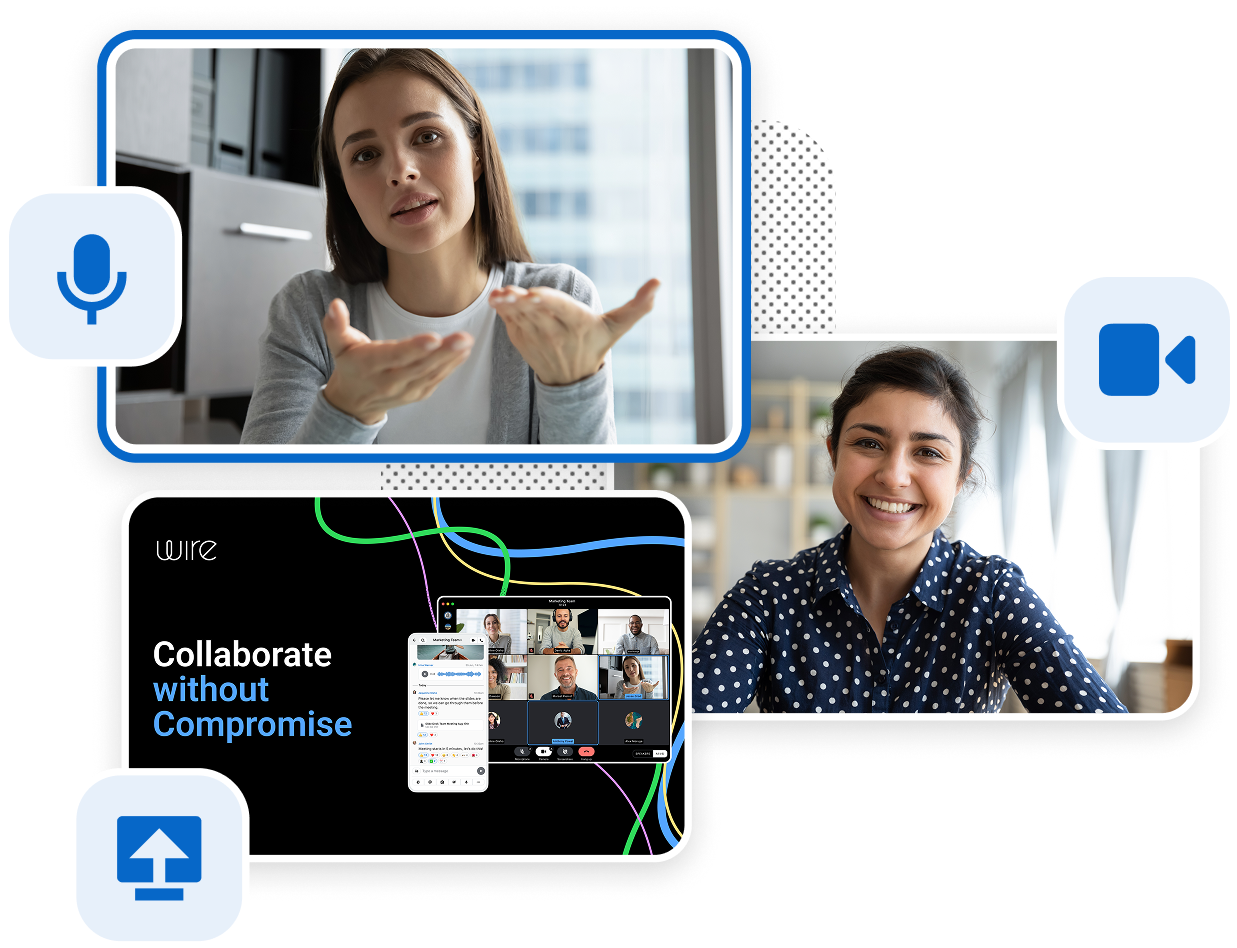The Most Secure Messaging App: Why Wire Outpaces the Competition
From end-to-end encryption (E2EE) to compliance, discover why Wire is the top choice for organizations that take security seriously, without compromising on anything.

How Wire Covers All Your Security Needs, Without Compromising Anything.
| Feature | Wire | Slack | MS Teams | Element | Threema |
| Everything End-to-End Encrypted, by Default | |||||
| Only Local Encryption Key Storage | |||||
| Messaging Layer Security (MLS) | |||||
| Consistent Cryptographic Protocol Protection | |||||
| Post-Compromise Security | Not default | ||||
| Perfect Forward Secrecy | |||||
| Zero Trust Architecture | Not native | Not native | |||
| Device Verification | |||||
| Fleet Device Verification | |||||
| User-Controlled, Encrypted Backup & Recovery | |||||
| Always E2EE File Sharing | |||||
| Encrypted Large Group Calling | |||||
| Secure, Spam-Free Federation | Open-by-default | Open-by-default | |||
| SSO with SCIM 2.0 Automation | |||||
| Full Deployment Options (Public Cloud, Private Cloud, On-Prem) | |||||
| BSI-approved instrument for German Digital Sovereignty |
Wire Bund | |
|
Wire vs Other Messaging Apps: Detailed Comparison
Wire vs. Telegram
Privacy and security compared inside out
Coming soon
Wire vs. Teamwire
A closer look at enterprise security and compliance
Coming soon
Don’t Settle for “Security” When It’s Only Skin-Deep.
Is There Any Reason for Your Enterprise to Keep Choosing “That” Security?
| Claim | What They Say | The Reality |
| "We have encryption" |
Data encrypted in transit and at rest. |
That’s not end-to-end encryption. Admins or providers can access your data. |
| “You control your workspace.” | You can assign admins and manage users. | Keys aren’t locally managed. Weak or no device verification. |
| “E2EE is available.” | Offered for 1:1 chats (beta), or must be enabled manually. | Not turned on by default for everything. Not scalable. And rarely includes file sharing or group calls. |
|
“Enterprise-ready.” |
Claims of compliance and integrations. | But no support for on-prem, federation, or fleet device oversight. |
| “Encrypted calls.” | Marketing says “secure calling.” | But calls are often only encrypted in transit, not end-to-end. |
Built to Meet Enterprise Demands.
-
Security & Privacy
-
Core Messaging
-
Integration & Ecosystem
-
Management
- Everything E2EE by Default: No user setup. No Opt-In. No exceptions. No excuses.
- Local Key Storage: Only user devices can ever decrypt messages.
- Post-Compromise Protection: Future messages remain secure even after key leaks.
- Zero Trust & Zero Knowledge: Built on strict identity and encryption principles. Not even admins could access the messages.
- Secure 1:1 & Group Chat: Encrypted chats, voice, and file sharing.
- History Sharing: E2EE chat history sync across verified devices.
- Large Encrypted Calls: Host secure calls up to 2000 participants.
- Rich Chat Features: Markdown, GIFs, reactions, voice messages, voice filters, and text formatting.
- Flexible Deployment: Various deployment options according to your needs: public cloud, private cloud, or on-prem.
- Federation: Communicate securely across backends, at scale
- App Integrations: Add bots, CRMs, task tools, and more.
- Custom SLAs & Configs: Tailor deployment, support, features, and more.
- RBAC & SCIM: Granular user roles and automated account provisioning.
- Policy Enforcement: Lock down file sharing, message editing, more.
- Guest Access Management: secured guest access and guest rooms creation.
- SSO Support: Smooth, enterprise-grade identity management with domain registration and SAML/OIDC.

Fully Open-Source Security for Verified Collaboration
Wire is one of the few secure collaboration platforms that is fully open source, from protocol to application. This means no black boxes, no hidden logic, no key escrow, and full auditability. With Wire, you get transparent, peer-reviewed cryptography plus the highest industry certifications:
- ISO 27001
- ISO 27701
- FedRAMP
- FIPS 140-2
- NIST 800-17
Global Leader in MLS Innovation with the IETF
Wire co-founded MLS with the IETF—the premier Internet standards body—to fix the limits of old encryption protocols for the real world. Today, Wire is the first and only enterprise collaboration suite fully secured by MLS. Governments, public sector agencies, regulated industries, and NGOs trust Wire to deliver scalable, effortless, verified protection for messages, calls, and files, now and for the future.

Why Security-First Teams Choose Wire
“Wire keeps our distributed team in sync: quickly, securely, and without distractions. It's exactly what a modern communication tool should be."

"Wire's robust end-to-end encryption has completely transformed our communication, empowering us to collaborate seamlessly and securely no matter where we are."

Frequently Asked Questions
Why is it important to secure communications for everything to be end-to-end encrypted by default?
End-to-end encryption (E2EE) ensures that only the sender and recipient can read messages, not admins or other intermediaries. When E2EE is the default, it eliminates human error, misconfigurations, or policy gaps that could expose sensitive data. It prevents surveillance, data breaches, and insider threats, making it the gold standard for privacy and security. Without default E2EE, communications are only as secure as their weakest link. In today’s threat landscape, where interception is cheap and exploitation is fast, secure by default isn’t optional. It’s the baseline for trust, safety, and digital sovereignty. That’s why messaging and collaboration systems that don’t offer E2EE or that turn it off by default, even in portions of their product functionality, are simply not secure enough for organizations that are intent on privacy, protection, and compliance of sensitive or classified data.
What’s the difference between central and local encryption key storage, and why does it matter in E2EE secure communications?
In E2EE, local key storage means that encryption keys are stored on the user's device, ensuring only they can decrypt messages. Central key storage places keys on a server, exposing them to breaches, insider threats, or surveillance. This difference matters: with local storage, even admins can’t access your messages. True E2EE requires keys to be device-held—centralized key control breaks the end-to-end model and compromises security and privacy.
What is Messaging Layer Security (MLS) and why is it the strongest protocol for secure communications?
Why is it essential for all secure communications features to be protected consistently by the same, strong protocol?
Using one strong, consistent protocol for all secure communication features ensures that every message, call, or file shares the same high level of protection. Mixing protocols creates weak spots—some data may be less secure or fall through the cracks. A unified protocol like MLS ensures end-to-end encryption, consistent key management, and streamlined audits, thereby reducing complexity, minimizing risk, and enhancing overall trust in the system. Security should never depend on which feature you're using.
What is post-compromise security, and what is required in a secure communications solution to deliver it?
Post-compromise security ensures that even if a device or key is compromised, past and future messages remain protected. To achieve it, secure communication systems must support frequent key updates, forward secrecy (protecting past messages), and post-compromise recovery (restoring security after a breach). Protocols like MLS (Message Layer Security) enable this by continuously rotating keys and isolating compromises, making long-term surveillance or message replay ineffective. It's critical for defending against persistent or advanced attackers.
What is perfect forward secrecy (PFS), and what is required to enable it in a secure communications platform?
Perfect forward secrecy (PFS) ensures that if long-term keys are compromised, past communications remain secure. It’s enabled by using ephemeral session keys that are generated for each conversation and discarded after use. To implement PFS, a secure communications platform must support protocols such as Diffie-Hellman key exchange, avoid key reuse, and ensure that keys are never stored in a long-term manner. PFS protects message history even if a device or server is later breached.
What does Zero Trust Architecture mean, and what are the key aspects of ZTA for secure communications?
Zero Trust Architecture (ZTA) means never trust, always verify—every user, device, and session must continuously prove its identity. In secure communications, ZTA requires strong authentication, least-privilege access, end-to-end encryption, and no implicit trust in networks or infrastructure. Keys must be user-controlled, not centrally stored. Combined with continuous verification, ZTA ensures that even if parts of the system are compromised, communications remain secure and compartmentalized.
What is fleet device verification, how does it differ from cross-signed device verification?
Fleet device verification refers to the ability to automate organization-wide device verification in conjunction with an Identity Provider (IdP). Fleet verification meets enterprise-class security needs by eliminating the need for manual verification. Fleet verification also ensures that verification is based on a highly trusted certificate authority, rather than on user self-verification as a foundation. Wire supports fleet device verification via our ID Shield feature.
How do secure communications solutions support encrypted backup and recovery of messaging history, and what method is most secure?
Secure communications platforms support encrypted backup by locally encrypting message history with a user-held key before storing it in the cloud. For secure recovery, users must retain or re-enter the encryption key, often tied to a password or recovery phrase. The most secure method avoids server-side key storage entirely, using end-to-end encrypted backups with client-side key management, so only the user can decrypt the data, even during recovery. See our whitepaper.
Why should file sharing always be E2EE by default?
Always-on end-to-end encrypted (E2EE) file sharing ensures that files are protected from sender to recipient, just like messages. Without it, files may be stored or transmitted in an unencrypted format, exposing them to interception, tampering, or unauthorized access. Always E2EE means no shortcuts—files never touch the server in plaintext, and only intended recipients can decrypt them. It’s essential for maintaining confidentiality, integrity, and trust, especially when sharing sensitive documents or media.
Why is encrypted large group calling necessary for secure communications to be a complete solution?
E2EE encrypted large group calling (up to 50 participants) secures voice/video so only devices—not servers—can access content. It’s technically challenging due to key management, latency, and participant churn. But it’s essential: without secure group calling, enterprises must rely on separate, often less secure tools. To be a comprehensive communications solution, platforms must protect all channels—chat, files, and meetings—under a single E2EE umbrella, ensuring privacy and compliance across all collaboration modes.
What does secure, spam-free federation mean in the context of secure communication? What does it require, and why is it important for organizations protecting sensitive data?
Secure, SPAM-free federation requires strong server authentication, rate-limiting, and mutual trust policies with allowlists. To prevent abuse, the federation model must be closed; only pre-approved, vetted servers can connect. Open federation invites SPAM, spoofing, and malicious actors, as seen with email. A closed model ensures trust, accountability, and consistent security standards across domains. It’s essential for delivering secure, reliable communications at scale without sacrificing user experience or exposing organizations to threats.
What is SSO with SCIM 2.0 Automation, and why is it important for security?
SSO with SCIM 2.0 automation means users can sign in with a single identity provider (like Okta or Azure AD), while SCIM 2.0 automates user management—provisioning, deprovisioning, and role updates—in real time. Together, they simplify access control, reduce admin overhead, and enhance security by ensuring only authorized users have access. It’s essential for enterprises managing large teams, as it enables seamless onboarding and instant revocation of access when employees leave or change roles.
Why is it important to enterprises and governments to be able to deploy a secure communications platform flexibly (Multi-tenant cloud service, private cloud, and on-premises deployments)?
Flexible deployment—multi-tenant cloud, private cloud, or on-premises—is essential for enterprises and governments to meet security, compliance, and sovereignty requirements. Large organizations often need to let different business units choose the deployment model that best fits their risk profile and regulatory environment. Some require full control (on-prem), others regional data residency (private cloud), while many prefer scalability (multi-tenant). This flexibility ensures secure communications without compromising on performance, policy, or operational autonomy.
See Wire in action
Discover how Wire enables secure, compliant, and seamless collaboration for your team - without compromising usability or control.